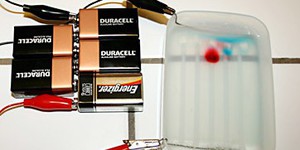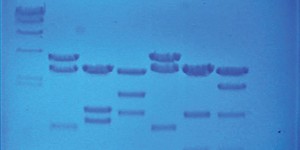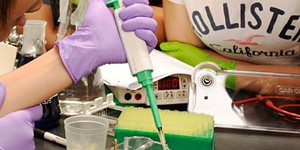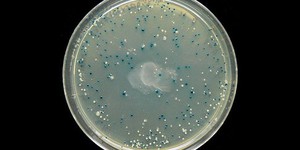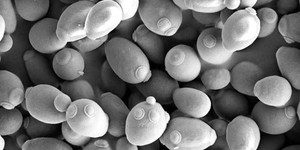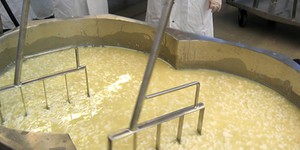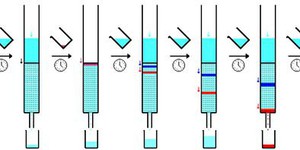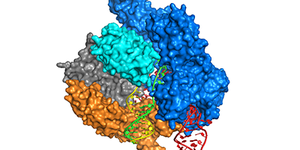Tenth Grade, Biotechnology Science Projects (17 results)
Yogurt, biofuel, biodegradable plastics, and antibiotics are all examples of products based on biotechnology research and manufacturing techniques. What else will we be able to create as we use biotechnology in new ways?
|
Select a resource
Sort by
|
When biologists want to separate different pieces of DNA, RNA, or proteins they use a technique called gel electrophoresis. In this science project you'll build a gel electrophoresis chamber and use it to discover how many components are in different colors of food coloring dye.
Read more
Featured
Have you heard that garlic powder is supposed to inhibit the growth of bacteria? Which do you think would make a better disinfectant: a solution of garlic powder or a solution of bleach? This project shows you a straightforward way to compare the effectiveness of different disinfectants (or other antimicrobial agents), by measuring zones of inhibition on a culture plate.
Read more
Are biofuels the wave of the future? People often talk about these plant-derived fuels as a way to someday cut down on our dependency on non-renewable carbon-based fuels, like gasoline. Ethanol (a type of alcohol) is a common biofuel used today. In the United States, ethanol is a common biofuel additive to normal gasoline. In fact, some states mandate that when you fill up your gas tank, 10 percent of the total fuel volume be made of ethanol. Brazil, the world's second largest user of…
Read more
New
Drones are small, fast, and maneuverable - this can make them very hard to knock down! Check out this Mark Rober video where he explores both how professional defense companies and some backyard YouTube engineers tackle the problem of knocking drones out of the sky. Can you take this engineering challenge on yourself? What methods can you devise to take down a drone? Which one works the best?
Drones can be expensive, and you probably do not want to risk damaging a $1,000 drone for your science…
Read more
Are you interested in the technical and ethical aspects of genetic screening, forensic science, and DNA fingerprinting? Scientists use different forms of a gene, called alleles, to differentiate between two fingerprints. One such sequence used in human DNA fingerprinting is the Alu repeat (a 300 base pair repetitive sequence of DNA) on chromosome 16. During evolutionary time, up to 1 million copies of the Alu repeat have become randomly inserted throughout the human genome. Within a specific…
Read more
Though the Sun provides heat and light, which are essential for life on Earth, ultraviolet (UV) rays in sunlight can cause damage to DNA. In this science fair project, you will experiment with a strain of yeast that is super-sensitive to UV light. This project will demonstrate the lethal effects of UV light when DNA damage is not repaired.
Read more
Genetically modified organisms (GMOs) are organisms whose DNA have been manipulated to give them new traits. In genetically modified (GM) food crops traits like resistance to drought or pesticide might be added, or the crop may have been made more nutritious, or the taste may be altered to give you something like the impossible burger. Are there GMOs in your favorite foods? Many countries have implemented or are in the process of implementing GMO labeling on foods, but with a little bit of…
Read more
New
Does your dog get bored when you are not home? Do you ever toss them a few treats right before you head out the door? What if you could keep them busy by automatically dispensing treats throughout the day? What about training them to sit in a certain place or even press a button by automatically rewarding them with treats? In this project you will build your own automatic dog (or cat, or other pet) treat dispenser that you can customize to react to different sensors.
Read more
Can bacteria be altered to produce life-saving insulin for diabetics? Or change color to indicate the presence of a harmful toxin? Yes, it can! Using biotechnology, scientists work daily on problems like these. It starts with selecting a gene you want bacteria to produce and creating a sequence of DNA that has that gene and a promoter that will help express it at the right time and at the right levels. The next hurdle is actually getting this engineered DNA into the bacteria and…
Read more
Can you imagine a glowing loaf of bread? You might not be able to make the whole loaf glow, but you can get baker's yeast to fluoresce! The way to do this is to modify the genetic information of the yeast organism. The technology that is used to do this is called genetic engineering. With genetic engineering, you can insert a fluorescent protein gene from a jellyfish into yeast cells, so they start glowing under blue light! Do this project to see for yourself!
Read more
Have you ever gone to pour yourself a cup of milk and all you get is milk clumps? What happened to the milk is called coagulation, which is the mechanism that occurs when proteins in the milk clump together. While you do not necessarily want this in your milk, without coagulation (or curdling), there would not be any cheese or yogurt, which is why it is a very important process in the food industry. But what makes milk curdle? In this science project you will use pineapple juice to curdle milk…
Read more
What color is grape soda? If you pour it into a clear glass you can easily see it is purple, but that is usually not its natural color. Manufacturers add red and blue dye to the soda. The dyes mix together and you get purple soda. What if you wanted to un-mix the dyes, could you? Yes! In a chemistry laboratory, using a technique called column chromatography, you could separate the two dyes again. But what about at home, can you use low-tech supplies to do the same thing? In this science…
Read more
Many scientists are currently very excited about CRISPR, as it has the potential to revolutionize gene editing. But what exactly is CRISPR and what does it do? CRISPR is a novel tool in gene editing that allows the modification of genetic DNA at specific target sites in many different organisms. Researchers have high hopes that this technology can, one day, cure genetic diseases, as mutated DNA sequences can easily be corrected. In this project, you will use CRISPR to mutate a DNA sequence…
Read more
|
Explore Our Science Videos
Explore Enzyme Activity!
Gear Ratio for the Junior Solar Sprint
How to Measure Light with Google's Science Journal App

